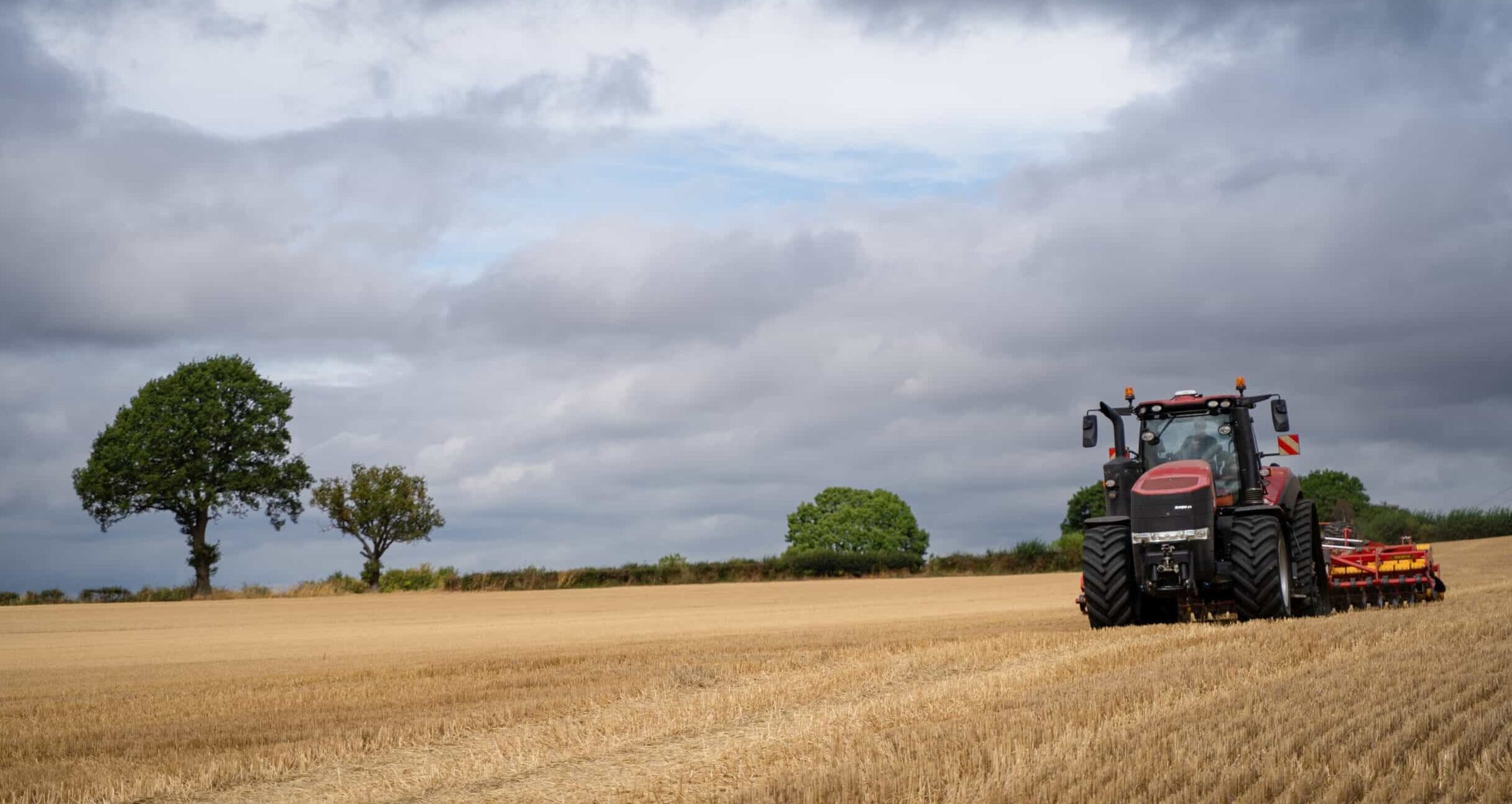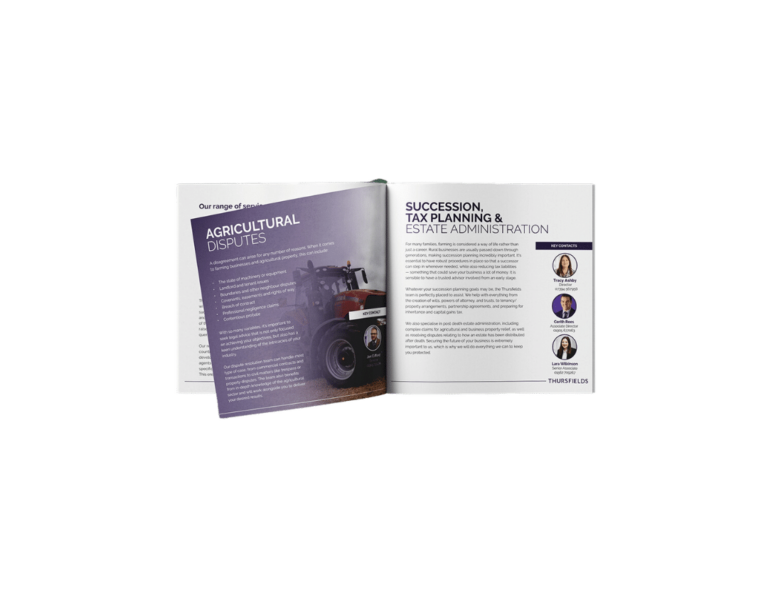A Guide to Agricultural Relief
Inheritance tax (IHT) is an important consideration for farmers who want to protect their assets and provide for future generations. Agricultural Relief (AR), formerly known as Agricultural Property Relief (APR), offers solutions for farm owners, as it can help to minimise potentially significant IHT liabilities.
Whether you’re an experienced farmer or an entrepreneur, we can help you to navigate the intricacies of inheritance tax on farmland. Thursfields is a full-service law firm with a speciality in helping landowners make informed decisions that can secure the future of agricultural assets.
Inheritance Tax on Farms: When is it Due?
Inheritance tax on farms is due when the owner passes away and the value of assets being transferred exceeds the standard IHT threshold of £325,000. This is known as the nil-rate band. With the average UK farm being worth around £2m, applying the standard IHT rate of 40% would work out at a significant £670,000 contribution (depending on exactly what allowances are available to the individual in question.
However, there are reliefs unique to agricultural property that can greatly reduce inheritance tax on farms. The most common reliefs are Agricultural Relief (AR) and Business Relief (BR). If your farm has been in operation for at least the past two years, it will usually be classed as a working farm and may qualify for APR.
What is Agricultural Relief?
Agricultural relief is widely considered to be the most effective way for farmers to minimise inheritance tax on agricultural land. It is available on plots of land that are used explicitly for agricultural purposes, along with any buildings that are also used specifically for farming. Agricultural land basically describes any area that has been used in the previous two years for the likes of:
- Crop growing
- The rearing/breeding of horses
- Short rotation coppice/ timber harvesting
- Any land not being farmed under a habitat scheme
- Any land not being used as part of a crop rotation scheme
- Farm buildings, cottages, and farmhouses
The intention of AR is that owners of agricultural properties, such as farmland, woodlands, farm buildings, can pass on these assets without incurring an unmanageable tax burden. Ultimately, the relief aims to avoid forced sales that might arise as a result of the high tax liabilities of inheritance tax on farmland upon the owner’s death.
It’s important to note that AR is only applicable against the agricultural value of land being used for farming. This figure is not the same as the market value of all available land. Usually, the agricultural value of a plot of land concerns only farmable land and is much less than if the entire estate was being sold to developers.
If you are considering estate planning, it’s advisable to take guidance from a legal specialist as soon as possible.

When is Agricultural Relief Applied?
To qualify for Agricultural Relief, the farm must have been occupied and used for farming purposes for the past two years by the person transferring their estate. Alternatively, the property will need to have been owned by the person transferring their estate for the past seven years while being used for farming. In the latter example, the owner need not have personally occupied the land during the preceding seven years.
Where applicable, the full AR rate of 100% is widely used. However, a reduced rate of 50% may be applied in certain circumstances. The application can be complex, so using a law firm with a specialism in agriculture is usually the best way to approach inheritance tax on farmland.
When is Agricultural Relief Not Applied in Full?
Although Agricultural Relief is broadly applied at the full rate of 100%, there are some exceptions. The reduced rate of 50% applies to a range of situations where the property doesn’t meet all of the conditions needed for full relief. Here are a few common scenarios in which AR might be reduced to the lesser rate of 50%:
- Diversification of Land Use: If the property includes land or assets that are not being used mainly for agricultural purposes, the value of those features might not qualify for 100% relief. For instance, if some of the land is being used for non-agricultural activities such as holiday cottages, or other commercial ventures, the relief might be restricted to 50% for that portion of the overall property.
- Farmhouses: Farmhouses that are occupied by the farmer and used for farming purposes will qualify for the full 100% relief, but some circumstances might result in a reduction. For example, if the farmhouse is not being used for agricultural purposes, or is not occupied by the farmer, the relief could be reduced to 50% or even excluded altogether.
- Conservation Purposes: Land used for nature conservation might not always qualify for the full 100% relief, particularly if the lands/woodlands are not actively being farmed or otherwise used for commercial agricultural purposes.
- Unused Land: If parts of the property are not actively used for agricultural activities, they might not be eligible for the full relief. This could include any portions that have been set aside, are lying fallow, or being used for any other non-agricultural purposes.
Determining which rate of AR is applicable can be complex. If you’re concerned about the implications of inheritance tax on agricultural land, it’s important to seek legal advice tailored to your personal circumstances.
What is Business Relief?
If someone has assets related to farming and wants to pass them on after they’re gone, Agricultural Relief might not help with the gap between agricultural value and market value. Instead, Business Relief (BR) could be used. This can lower the taxable value of business-related assets for tax purposes when passing them on through inheritance.
The amount of the BR reduction depends on whether a share in the business is being sold, or certain assets like land, buildings, or machinery. In order to qualify for BR, the business must have been owned by the person transferring the estate for the past two years. Typically, AR will be applied to the estate first, with BR being applied after agricultural value has been established and factored in.

Thursfields is an Expert in Agricultural Law
Navigating the intricacies of Agricultural Relief requires a comprehensive understanding of tax regulations and the unique challenges within the agricultural sector.
Thursfields has extensive experience in agricultural law and a proven track record of successful outcomes. We offer reliable guidance through the complexities of inheritance tax on farms, helping to ensure that your assets are preserved and transitioned for future generations. A full-service law firm we also offer in-house solutions across family law, employment law, commercial business, and more.
Using our services means entrusting your agricultural interests to a team that knows the sector and offers a commitment to securing your family’s future. Whether you’re a farmer, or landowner, we are dedicated to providing tailored legal solutions that can meet your needs.
Contact us today to benefit from a service that is built around you.
Get In Touch
With Us
Need expert legal advice? Our solicitors are here to help. Get in touch today.



